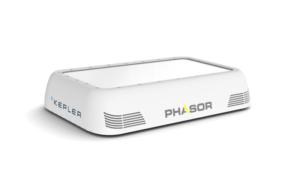Phasor, the developer of leading, enterprise-grade electronically-steerable antenna systems, and Kepler, a low-Earth orbit (LEO) satellite operator and telecommunication services provider today announce successful tests between Kepler’s first in-orbit LEO nanosatellite and Phasor’s wideband electronically-steered antenna.

Kepler’s satellite, KIPP, launched in January, represents the first example of a wideband LEO satellite to have been auto-acquired, auto-tracked, and communicated with, by a commercial flat panel, electronically-steerable antenna.
Phasor’s market-leading new antenna successfully acquired, tracked and received transmissions from KIPP as it passed over Phasor’s test range facility in the UK. Further tests will be performed in the coming days and weeks. The highly anticipated industry milestone opens the door to a wide range of novel applications that can benefit from phased array antenna technology, which the duo intend to address.
Kepler CEO, Mina Mitry, said:
“This is a big moment in satellite communications history. We are combining the capabilities of our ultra-low-cost nanosatellites together with Phasor’s high-performance, electronically-steerable antenna technology to unleash the potential of high-speed LEO Ku-band mobile connectivity”
“We have a number of customer applications for which we are deploying services today, which would benefit from Phasor’s technology”
“Our customers, for instance, would benefit from the ability to dynamically and seamlessly switch between satellite networks to optimize traffic management. We also have customer use cases where mechanically actuated antennas are impractical because of their need to operate in extreme environments, so high-gain antennas without moving parts is a huge value-add for our customers.”
Dave Helfgott, Phasor CEO, said:
“The Kepler-Phasor collaboration promises to bring to market real capabilities for a broad range of markets, including maritime, transportation, natural resources, defense, IoT and a wide variety of other on-to-move applications”
“This is an exciting beginning, and we look forward to many more milestones to come.”
For the test, Phasor’s antenna was able to track KIPP for its entire pass down to 20o elevation angle, demonstrating the viability of the 70o scan angle available from the Phasor electronically-steerable antenna.
The LEO to electronically steered antenna transmission received a signal-to-noise ratio (SNR) in excess of 9dB, as was intended in the testbed design.
Kepler CTO, Wen Cheng Chong, said:
“Early results show us we have the capacity for around 20 Mbps to Phasor’s flat panel antenna with our 3U spacecraft. We are excited to further validate that capability in future testing.”
About Phasor, Inc.
Phasor Inc. is a leading developer of high throughput, enterprise-grade, modular phased array antennas, headquartered in Washington DC, with a technology development subsidiary in London. Phasor’s electronically steerable antennas (ESAs) are based on patented innovations in dynamic beam forming technologies and system architecture. Phasor’s mission is to enable high-speed broadband communications while in-flight, at sea or travelling over land.
About Kepler Communications, Inc.
Kepler is a satellite telecommunications provider based in Toronto, Canada, backed by IA Ventures and other leading investors. Kepler aims to build an in-space telecommunications network through an incremental deployment of products and technologies.




